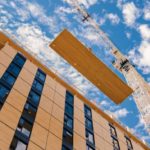High Rises Made of Wood?
Posted: December 26, 2017Source: Scientific American
Tall timber high-rises could produce fewer emissions and sequester carbon dioxide
- What – Brock Commons Tallwood House
- Height – 18 stories, 53 meters
- Avoided Greenhouse Gas Emissions – 679 metric tons of CO2
- Carbon Stored in the Wood – 1753 metric tons of CO2
- Total Potential Carbon Benefit – 2432 metric tons of CO2

Brock Commons, Vancouver. Courtesy ofStructurlam
A wood skyscraper might sound like a bad idea—and potentially a giant tinderbox. But architects around the world are steadily building more timber high-rises, partly with the aim of curbing carbon pollution.
Lofty wood buildings are popping up in major cities from London to Melbourne. Many more are in the works—soon Portland, Ore., will be getting its own—and they continue to break height records for modern lumber construction. The world’s tallest such building completed, a 53-meter Vancouver high-rise called Brock Commons, officially opens in September.
Wood is strong, lightweight, and resilient to earthquakes, says Russell Acton, a principal architect at Acton Ostry Architects, which designed Brock Commons. And the thick pieces of wood used in such buildings are in fact surprisingly fire-resistant—when burned, they form an outer layer of char that can protect the material underneath. Timber also has environmental benefits: it is a sustainable resource—as long as forests are properly managed—and appears to emit less carbon dioxide over the course of its production (from living trees to finished buildings) than traditional materials such as steel and concrete. In addition, trees naturally sequester carbon and thus help to keep greenhouse gases out of the air.
Fittingly, wood skyscrapers are helping cities “go green.”

